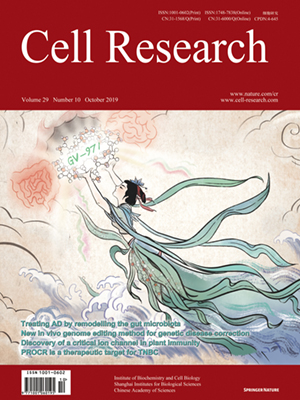
Advanced Search
Submit Manuscript
Advanced Search
Submit Manuscript
Volume 29, No 10, Oct 2019
ISSN: 1001-0602
EISSN: 1748-7838 2018
impact factor 17.848*
(Clarivate Analytics, 2019)
Volume 29 Issue 10, October 2019: 804-819
Keiichiro Suzuki 1,2,3 , Mako Yamamoto1 , Reyna Hernandez-Benitez 1, Zhe Li4 , Christopher Wei4, Rupa Devi Soligalla 1,5 , Emi Aizawa 1,3, Fumiyuki Hatanaka1, Masakazu Kurita 1,5, Pradeep Reddy 1, Alejandro Ocampo1, Tomoaki Hishida1, Masahiro Sakurai 1,5,Amy N. Nemeth1, Estrella Nuñez Delicado5, Josep M. Campistol6, Pierre Magistretti7, Pedro Guillen8, Concepcion Rodriguez Esteban1,Jianhui Gong 9,10,11,12, Yilin Yuan 9,10,11, Ying Gu 9,10,11, Guang-Hui Liu 13, Carlos López-Otín 14, Jun Wu 5,15,16, Kun Zhang 4 and Juan Carlos Izpisua Belmonte 1
1 Gene Expression Laboratory, Salk Institute for Biological Studies, La Jolla, CA 92037, USA; 2Institute for Advanced Co-Creation Studies, Osaka University, Osaka 560-8531, Japan; 3Graduate School of Engineering Science, Osaka University, Osaka 560-8531, Japan; 4Bioengineering, University of California, San Diego, 9500 Gilman Drive, MC0412, La Jolla, CA92093-0412, USA; 5Universidad Catolica, San Antonio de Murcia, Campus de los Jeronimos, 135, Guadalupe 30107, Spain; 6Hospital Clinic of Barcelona, Carrer Villarroel, 170,08036 Barcelona, Spain; 7King Abdullah University of Science and Technology (KAUST), Thuwal 23955-6900, Saudi Arabia; 8Fundacion Dr. Pedro Guillen, Clinica CEMTRO, Avenida Ventisquero de la Condesa, 4228035 Madrid, Spain; 9BGI-Shenzhen, Shenzhen 518083, China; 10 Guangdong Provincial Key Laboratory of Genome Read and Write, Shenzhen 518120, China; 11 Guangdong Provincial Academician Workstation of BGI Synthetic Genomics, BGI-Shenzhen, Guangdong, China; 12 Shenzhen Engineering Laboratory for Innovative Molecular Diagnostics, Shenzhen 518120, China; 13 National Laboratory of Biomacromolecules, CAS Center for Excellence in Biomacromolecules, Institute of Biophysics, Chinese Academy of Sciences, Beijing 100101, China; 14 Departamento de Bioquímica y Biología Molecular, Facultad de Medicina, Instituto Universitario de Oncología (IUOPA), Universidad de Oviedo, Oviedo, Spain; 15 Department of Molecular Biology, University of Texas Southwestern Medical Center, Dallas, TX 75390, USA and 16 Hamon Center for Regenerative Science and Medicine, University of Texas Southwestern Medical Center, Dallas, TX 75390, USA
https://doi.org/10.1038/s41422-019-0213-0